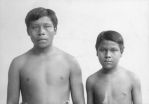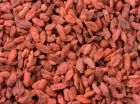(Press-News.org) A University of Leicester researcher has discovered two photographic images, presumed lost, of native Americans brought to Britain by Roger Casement a century ago.
Dr Lesley Wylie, Lecturer in Latin American Studies in the School of Modern Languages, University of Leicester, made the discovery during her research for a book on the Putumayo, a border region in the Amazon. Her book forms part of the AHRC-funded research project, American Tropics: Towards A Literary Geography, based at the University of Essex.
The photographs were found among a photographic collection relating to the period of the rubber boom in the Putumayo held by the University of Cambridge's Museum of Archaeology and Anthropology.
They depict the subjects naked to the waist against a pale background, in half-length front and profile shots, in accordance with the genre of anthropological photography at that time. The photographs were taken by John Thomson, a pioneering travel photographer and photojournalist, born in Edinburgh.
Dr Wylie, who has published the photographs in the Irish Studies Review described the find as 'very exciting'. She said:
'The photographs essentially reduce the subjects to racial "types": the man and boy are no longer regarded as individuals but as physical specimens supposedly embodying certain racial characteristics. This privileging of the visual was an important feature of British imperial policy of the time. Although the two Amazonians were not British subjects, these photographs can be situated within a tradition of imperial photography which sought to record and document human "types".'
The images have been published as part of a research paper on Roger Casement – remembered as an Irish revolutionary and co-conspirator in the Dublin Easter Rising for which he was hanged in 1916.
Casement made his trip to the Amazon in 1910 and again in 1911 on behalf of the British government to investigate alleged atrocities against the indigenous population. These abuses were allegedly carried out by a Peruvian rubber company owned by British shareholders and relying, partly, on labour from British colonies in the Caribbean. Although undertaken just a few years before Casement was hanged for treason, this trip and his subsequent report confirm both the high regard in which he was held by the British establishment and his commitment to human rights.
Casement brought back more than verbal or written testimony of what he discovered in the Amazon - he arranged to have two 'natives' shipped back so that he could introduce them to leading figures of the British establishment and arrange for them to be painted and photographed.
The two Amazonians were called Omarino and Ricudo. Omarino had been 'presented' to Casement for payment of a pair trousers and a shirt while Ricudo, a married man of 19, had been separated from his wife after Casement 'won him' in a game of cards.
Dr Wylie said that, despite the fact that today these ethnographic photographs strike us as somewhat dehumanising, Casement's decision to commission them would not have been out of the ordinary in 1911; rather, it was consistent with the racial ideology of the time. This in itself is of interest to researchers, since Casement has so often been regarded as resistant to this colonial mindset.
Dr Wylie said: 'I came across the two photographs among a photographic collection held by the University of Cambridge's Museum of Archaeology and Anthropology. Although the catalogue card identified the sitters simply as "Two slaves from Putomayo (sic) river, Up. Amazon, Colombia", I suspected immediately that they were the two Amazonians that Casement had brought to London in 1911. I had previously seen a copy of William Rothenstein's painting of the subjects, and there was a strong resemblance between it and the photographs. Although Casement mentions the existence of these photographs in his personal correspondence, scholars had assumed up to now that these images had been lost.'
Casement's motives, says Dr Wylie, were to raise awareness of the Putumayo atrocities. He wrote in his journal: 'My hope is that by getting some of these unknown Indians to Europe I may get powerful people interested in them and so in the fate of the whole race out here in the toils'.
He also held out hope that what he called the 'paternalistic white man' would save the Putumayo from the plight of slavery to the rubber company: 'Is it too late to hope that by means of […] humane and brotherly agency something of the good-will and kindliness of Christian life may be imparted to the remote, friendless, and lost children of the forest still waiting the true whiteman's coming into the region of the Putumayo?'
Dr Wylie's research reconstructs the brief period the two Amazonians spent in London in the summer of 1911 and how they were perceived as 'living curiosities' and 'native types'. On 1 August 1911, the two Amazonian youths even made it to the front page of The Daily News. They are reported to have said: "London is very beautiful, but the great river and the forest, where the birds fly, is more beautiful. One day we shall go back."
Dr Wylie adds: 'Whilst it has been possible at least partially to reconstruct the story of Omarino and Ricudo, and their trip from the forests of the Amazon to the busy streets of London, many other stories from the Putumayo, then and now, remain untold.'
'As part of my research I came across testimony given by Omarino and Ricudo recounting stories of violence, displacement, and murder. Today, indigenous communities in the Putumayo, now in the war-torn south of Colombia, are bearing the brunt of the latest tropical boom – in cocaine rather than rubber – as well as ongoing political violence.'
INFORMATION:
Notes to editors
The article by Dr Lesley Wylie, University of Leicester School of Modern Languages, appears in Irish Studies Review.
To cite this Article: Wylie, Lesley (2010) 'Rare models: Roger Casement, the Amazon, and the ethnographic picturesque', Irish Studies Review, 18: 3, 315-330
To link to this Article: DOI: 10.1080/09670882.2010.493024
URL: http://dx.doi.org/10.1080/09670882.2010.493024
For interviews: Dr Lesley Wylie
Lecturer in Latin American Studies
School of Modern Languages
University of Leicester
Email: lw136@le.ac.uk
Telephone: +44 (0)116 252 2668
Or contact University of Leicester press office: 0116 252 2415. pressoffice@le.ac.uk
Arts & Humanities Research Council (AHRC): Each year the AHRC provides approximately £112 million from the Government to support research and postgraduate study in the arts and humanities, from languages and law, archaeology and English literature to design and creative and performing arts. In any one year, the AHRC makes approximately 700 research awards and around 1,350 postgraduate awards. Awards are made after a rigorous peer review process, to ensure that only applications of the highest quality are funded. The quality and range of research supported by this investment of public funds not only provides social and cultural benefits but also contributes to the economic success of the UK. www.ahrc.ac.uk
AMERICAN TROPICS: TOWARDS A LITERARY GEOGRAPHY is a five year project funded by the Arts and Humanities Research Council. The project tries to do justice to the complexity of the literary history of the Americas, especially to those areas where more than one European power (and therefore language) had influence by approaching literary history in a completely different way, focused on place. It defines the American Tropics as a broad region (from Charleston to Bahia) where the plantation cultures flourished. From within that region it chooses six places on which to focus, giving intensive consideration to the writing associated with those places--irrespective of the language or national origin of the writers. The literary history of the Americas has usually been written backwards, with a teleological sense of what the boundaries of a particular nation would look like, even when dealing with literature produced when those boundaries were different or non-existent. This project takes a new approach in an attempt to grapple with what a truly comparative literary history might look like. The project focuses on a number of key places which have been nodal points for the production of writing, taking these as case studies including: Oriente (Cuba), New Orleans, the Haiti-Dominican Republic border, and the Putumayo. http://www.essex.ac.uk/lifts/American_Tropics/index.htm
Lost images of 'human exhibits' in Britain discovered
University of Leicester researcher finds photographs of Amazonians brought to London by Roger Casement
2010-12-17
ELSE PRESS RELEASES FROM THIS DATE:
Alcoholics beware -- genetic variation linked to liver cirrhosis in Caucasians
2010-12-17
A new study by German researchers found that a variation in the PNPLA3 (adiponutrin) gene was associated with cirrhosis of the liver and elevated transaminase (liver enzyme) levels in alcoholic Caucasians. The risk of cirrhosis in alcoholics in the genetic high risk group might be as high as 25% to 50%. Full findings are published in the January 2011 issue of Hepatology, a journal of the American Association for the Study of Liver Diseases.
Alcoholic liver disease (ALD)—ranging from alcoholic fatty liver to alcohol induced liver fibrosis and cirrhosis—accounts for more ...
Goji berries have the same nutrients as fruits and vegetables and a placebo effect
2010-12-17
While the consumption of Goji berries has risen dramatically over the last months, their properties have not been scientifically proven yet by any relevant clinical intervention study with humans. Most of Goji berries' components are contained in the recommended fruit and vegetable intake in balanced diets. The only difference is the "significant placebo effect" on people consuming them. Also, the species Lycium Barbarum –to which Goji berries exported from China belongs– originally comes from the Mediterranean and belongs to the Solanaceae family, the same family to which ...
No change in health gap between England's richest and poorest
2010-12-17
Significant health inequalities still exist between the country's richest and poorest according to the latest findings from the biggest annual survey of health in England, The Health Survey for England. The survey, conducted by the National Centre for Social Research and UCL and funded by The NHS Information Centre, shows that people in the lowest income households continue to experience much worse outcomes across key health measures than people in the highest income households.
Men and women in the lowest income bracket are three times more likely than those in the highest ...
Blocking the critical structure that lets cancer cells move -- their feet
2010-12-17
DURHAM, N.C. -- Scientists now know that some cancer cells spread, or metastasize, throughout the body the old-fashioned way -- by using their feet. But researchers at Duke Cancer Institute have discovered a way to short-circuit their travels by preventing the development of these feet, called invadopodia. This discovery is even more important because preventing the development of these "feet" also eliminates the action of proteins present in the feet that burn through intact tissue and let cancer cells enter new cells.
The results could yield a treatment to prevent the ...
Report: Policies to spur renewable energy can lower energy costs
2010-12-17
The South could pay less for its electricity in 20 years than is currently projected if strong public policies are enacted to spur renewable energy production and use, according to a report released today by researchers at the Georgia Institute of Technology and Duke University. The 190-page report, "Renewable Energy in the South," builds on a short policy brief released last summer and provides an in-depth assessment of the scope of renewable energy resources in the South and their economic impacts on electricity rates and utility bills in the region.
Skeptics of renewable ...
Kids got the blues? Maybe they don't have enough friends
2010-12-17
Montreal, December 16, 2010 – Friendless kids can become social outcasts who risk spiraling into depression by adolescence, according to new research from Concordia University, Florida Atlantic University and the University of Vermont. Yet for most shy and withdrawn children, the study reports in the journal Development and Psychopathology, friends can be a form of protection against sadness.
"The long-term effects of being a withdrawn child are enduringly negative," says lead author William M. Bukowski, a psychology professor and director of the Concordia Centre for ...
Evidence suggests e-cigs safer than cigarettes, researcher claims
2010-12-17
In a new report that bucks the concerns raised by the Food and Drug Administration, a Boston University School of Public Health (BUSPH) (sph.bu.edu) researcher concludes that electronic cigarettes are much safer than real cigarettes and show promise in the fight against tobacco-related diseases and death.
The review, which will be published online ahead of print this month in the Journal of Public Health Policy, is the first to comprehensively examine scientific evidence about the safety and effectiveness of electronic cigarettes, also known as e-cigarettes, said Michael ...
Films for façades
2010-12-17
Films instead of walls. This is an idea that fascinates architects all over the world. The Eden Project in Southern England, the National Aquatics Center built for swimming events at the Olympics in Beijing and the Allianz Arena in Munich are only three examples of what you can make from plastic sheets. Ethylene tetraflourethylene (ETFE), a transparent membrane, is especially popular because it enables buildings that shine in all colors as in Munich and Peking. But, we are not just talking about colors. You can use this new foil for an intelligent improvement of existing ...
Scientists identify the largest network of protein interactions related to Alzheimer's disease
2010-12-17
Through a complex analysis of protein interactions, researchers from IRB Barcelona and the Joint Programme IRB-BSC have discovered new molecular mechanisms that may be involved in the development of Alzheimer's disease. The study, a collaboration between bioinformaticians and cell biologists, was led by IRB Barcelona group leader and ICREA researcher Patrick Aloy and appears today in the Genome Research, a reference journal in the field of genomics.
Alzheimer's disease is an age-related neurodegenerative disease. Despite the considerable efforts made in recent years to ...
It's a pain to take care of pain
2010-12-17
INDIANAPOLIS –While many studies have looked at the treatment of chronic pain from the patient's perspective, there has been little research on those who provide care for chronic pain.
In a study in the November 2010 issue of the journal Pain Medicine, researchers from the Regenstrief Institute, the Indiana University School of Medicine, the IU School of Liberal Arts and the Roudebush VA Medical Center report that chronic pain takes a toll on primary care providers as well as their patients. They conclude that providers' needs should not be ignored if pain care is to ...
LAST 30 PRESS RELEASES:
Scientists trace microplastics in fertilizer from fields to the beach
The Lancet Obstetrics, Gynecology, & Women’s Health: Taking paracetamol during pregnancy does not increase risk of autism, ADHD or intellectual disabilities, confirms new gold-standard evidence review
Taking paracetamol during pregnancy does not increase risk of autism, ADHD or intellectual disabilities
Harm reduction vending machines in New York State expand access to overdose treatment and drug test strips, UB studies confirm
University of Phoenix releases white paper on Credit for Prior Learning as a catalyst for internal mobility and retention
Canada losing track of salmon health as climate and industrial threats mount
Molecular sieve-confined Pt-FeOx catalysts achieve highly efficient reversible hydrogen cycle of methylcyclohexane-toluene
Investment in farm productivity tools key to reducing greenhouse gas
New review highlights electrochemical pathways to recover uranium from wastewater and seawater
Hidden pollutants in shale gas development raise environmental concerns, new review finds
Discarded cigarette butts transformed into high performance energy storage materials
Researchers highlight role of alternative RNA splicing in schizophrenia
NTU Singapore scientists find new way to disarm antibiotic-resistant bacteria and restore healing in chronic wounds
Research suggests nationwide racial bias in media reporting on gun violence
Revealing the cell’s nanocourier at work
Health impacts of nursing home staffing
Public views about opioid overdose and people with opioid use disorder
Age-related changes in sperm DNA may play a role in autism risk
Ambitious model fails to explain near-death experiences, experts say
Multifaceted effects of inward foreign direct investment on new venture creation
Exploring mutations that spontaneously switch on a key brain cell receptor
Two-step genome editing enables the creation of full-length humanized mouse models
Pusan National University researchers develop light-activated tissue adhesive patch for rapid, watertight neurosurgical sealing
Study finds so-called super agers tend to have at least two key genetic advantages
Brain stimulation device cleared for ADHD in the US is overall safe but ineffective
Scientists discover natural ‘brake’ that could stop harmful inflammation
Tougher solid electrolyte advances long-sought lithium metal batteries
Experts provide policy roadmap to reduce dementia risk
New 3D imaging system could address limitations of MRI, CT and ultrasound
First-in-human drug trial lowers high blood fats
[Press-News.org] Lost images of 'human exhibits' in Britain discoveredUniversity of Leicester researcher finds photographs of Amazonians brought to London by Roger Casement



